General terms related to spherical mirrors: A mirror with the shape of a portion cut out of a spherical surface or substance is known as a...

General Terms Related to Spherical Mirrors
April 11, 2024
We have studied Triangles and types of triangles before. To understand the concept better, let us know the Properties of the Triangle. As we know, a triangle is a closed polygon with three sides, three angles, and vertices. There are types of triangles based on the length of their sides and angles. Properties of triangles are based on the triangle’s sides and angles.
This article will learn more about triangle properties, formulas, and types with some solved examples.
A triangle is a polygon that has three sides. It can also be defined by a figure bounded or enclosed by three-line segments.
Clearly, a triangle will have three sides and three vertices.
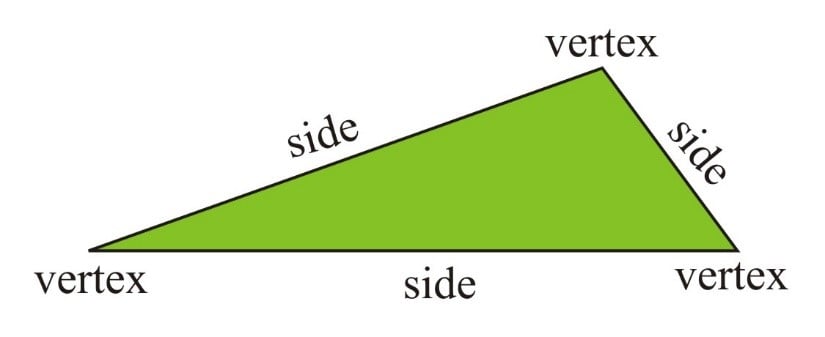
We will discuss some of the properties below.
Triangles are of 6 types, based on their sides and angles
Acute Angled Triangle
Oblique angled Triangle
Right Angle Triangle
Equilateral Triangle
Scalene Triangle
Isosceles Triangle
As discussed, the properties of triangles are based on the sides and angles, let us look at some of the triangle properties below:
The sum of all the three angles in a triangle is \({180^ \circ }\) or two right angles. This is called the angle sum property of a triangle.
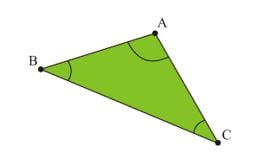
In \(\Delta ABC,\angle A + \angle B + \angle C = {180^ \circ }\)
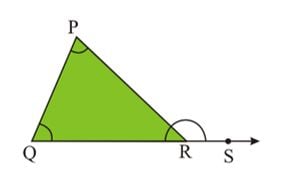
In a triangle \(PQR,\) if one of the sides is \(QR\) (say) is extended to\(S,\) then the \(\angle PRS\) is called the angle exterior to the triangle at the point \(R,\)
A very important property exists related to the exterior angle of a triangle. It can be proved that the exterior angle in a triangle is equal to the sum of the two extreme interior angles in a triangle.
In the above triangle \(PQR,\angle PRS = \angle PQR + \angle QPR.\)

The sum of exterior angles taken in order
\( = \angle 2 + \angle 4 + \angle 6 = \left({\angle 1 + \angle 2 + \angle 3 + \angle 4 + \angle 5 + \angle 6} \right) – \left({\angle 1 + \angle 3 + \angle 5} \right)\)
\( = \left({{{180}^ \circ } + {{180}^ \circ } + {{180}^ \circ }} \right) – {180^ \circ } = {540^ \circ } – {180^ \circ } = {360^ \circ }.\)
Therefore, the sum of all the three exterior angles in a triangle taken in order is \({360^ \circ }.\)
The altitudes of a triangle meet at a point. This point is called the orthocentre of the triangle.
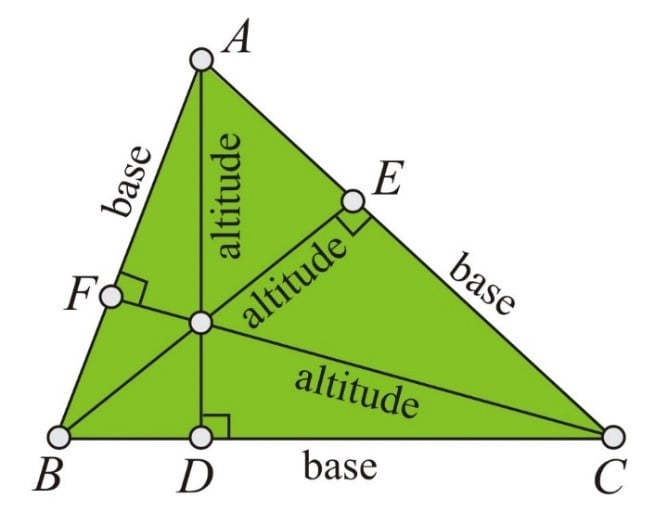
In any triangle, the three medians meet at a point.
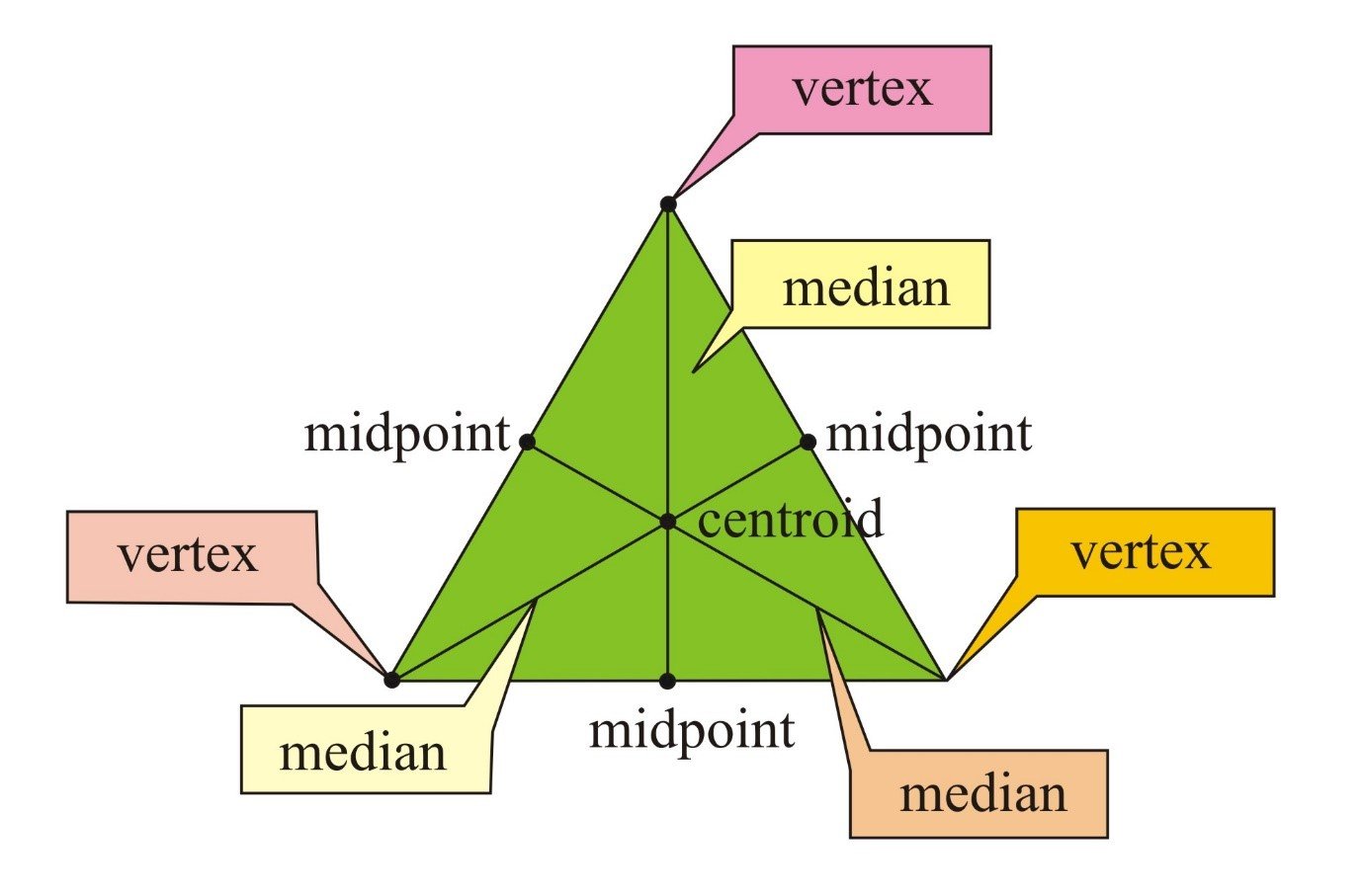
Centroid: The point of intersection of the medians in a triangle is called the centroid of the triangle.
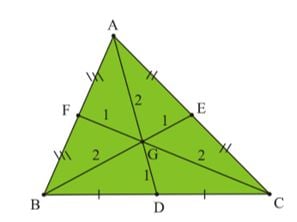
In the above triangle \(ABC,\) the medians \(AD,BE\) and \(CF,\) meet at point \(G.\) So, point \(G\) is called the centroid of the triangle.
In a triangle, the centroid divides each median in the ratio \(2:1.\) This is shown in the figure.
So, in triangle \(ABC,\) we have \(AG:GD = BG:GE = CG:GF = 2:1\)
Incentre: The point of intersection of the internal bisectors of the three angels in a triangle is called the incentre of a triangle.
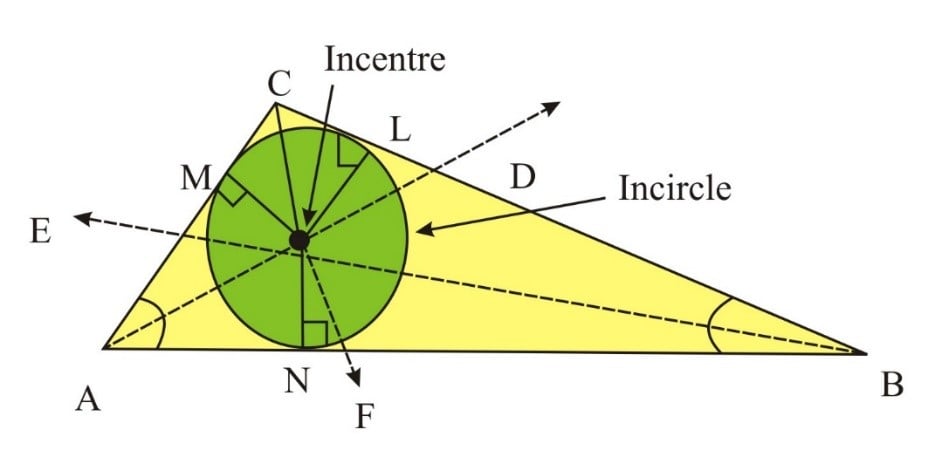
Now, from point \(I\) (centre), if a perpendicular is drawn on any side of the triangle and then, with this length of the perpendicular from the incentre and to the point where it is intersecting the side, a circle is drawn, this circle touches the other two sides. This circle is called the incircle of the triangle.
The Incentre of a triangle always lie inside a triangle irrespective of the shape of the triangle, i.e., whether the triangle is acute, obtuse, or right-angled, the incentre always lies inside a triangle.
Circumcentre: The three perpendicular bisectors of a triangle always meet at a point, and this point is called as circumcentre of the triangle.
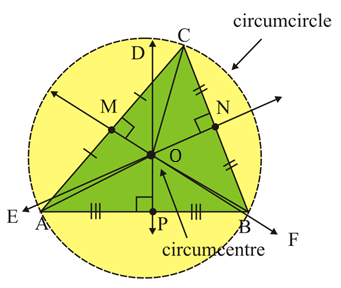
In triangle \(ABC,\) the perpendicular bisectors \(PD,NE\) and \(MF\) meet at point \(O.\) This point \(O\) is the circumcenter of the triangle.
Circumcircle: It is the circle drawn with the circumcentre as the centre and the distance between the circumcentre and any one of its vertices of the triangle as the radius.
In the above triangle, the circumcircle is drawn, taking \(O\) as the centre and \(OA\) as the radius. The circle drawn passes through the other two vertices \(B\) and \(C.\)

3. For a right-angled triangle, the circumcentre always lies on the hypotenuse of the triangle, as shown in the figure below.

The sides of a triangle fulfil an important property which is given below:
Property: The sum of any two sides of a triangle is greater than the third side. That is, in a triangle \(ABC,\) we have
\(b + c > a,c + a > b\) and \(a + b > c\)
This important property of a triangle is known as Triangle Inequality.
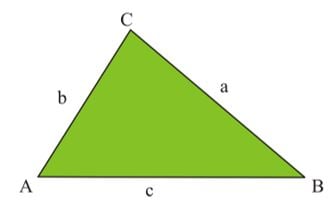
If two triangles are similar, then their
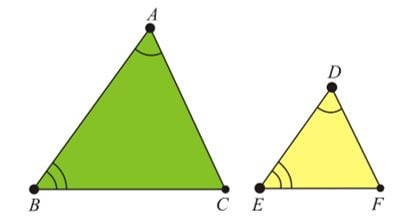
If \(\Delta ABC\) is similar to \(\Delta DEF,\) then \(\angle A = \angle D,\angle B = \angle E = \angle F\) and \(\frac{{AB}}{{DE}} = \frac{{BC}}{{EF}} = \frac{{AC}}{{DF}}.\)
Two triangles are said to be congruent if they exactly look alike, i.e., they have the same shape and size.
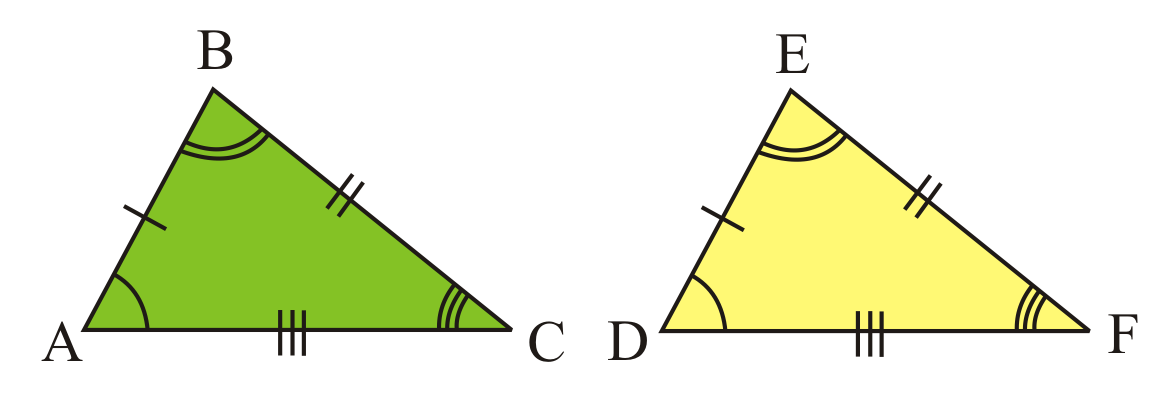
In the above figures, triangle \(ABC\) and triangle \(DEF\) look alike. They have the same shape and size. Hence, these two triangles will be called congruent triangles. The symbol used to represent congruency is \( \cong ,\) and it is read as ‘is congruent to’. Hence, in this case, the congruency between the tringles \(ABC\) and \(DEF\) is represented as \(\Delta ABC \cong \Delta DEF.\)
In two congruent triangles, the corresponding sides have the same length, and the corresponding angles have the same measure.
In \(\Delta ABC\) and \(\Delta DEF,\) clearly, \(AB = DE,AC = DF,BC = EF\) and \(\angle A = \angle D,\angle B = E,\angle C = \angle F.\)

The perimeter is obtained by adding the lengths of the three sides of the triangle.
The Perimeter of a Scalene triangle
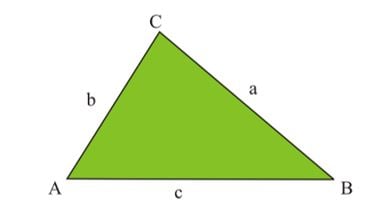
\(ABC\) is the scalene triangle with sides \(AB = c,BC = a\) and \(AC = b.\)
So, the perimeter of \(\Delta ABC = \) the length of the sides \( = AB + BC + CA = c + a + b = a + b + c.\)

\(ABC\) is the isosceles triangle with sides \(AB = BC = a\) and \(BC = b.\)
So, the perimeter of \(\Delta ABC = \) the length of the sides \( = AB + BC + = a + b + a = 2a + b.\)

\(ABC\) is the equilateral triangle with sides \(AB = BC = AC = a.\)
So, the perimeter of \(\Delta ABC = \) the length of the sides \( = AB + BC + CA = a + a + a = 3a = 3 \times {\rm{side}}\)
Area definition: The area of a triangle is the region or space enclosed by the three sides of the triangle
Area of a triangle \( = \frac{1}{2} \times {\rm{base}} \times {\rm{height}}\)
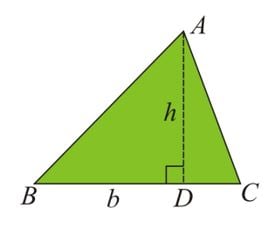

According to this formula, the area of a triangle is given by, area \( = \sqrt {s\left({s – a} \right)\left({s – b} \right)\left({s – c}\right),} \)
where \(a,b\) and \(c\) are the lengths of sides of the triangle and s is the semi-perimeter of the triangle, given by \(s = \frac{{a + b + c}}{2}.\)
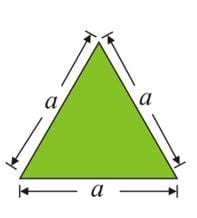
The area of an equilateral triangle is \( = \frac{{\sqrt 3 }}{4} \times {a^2} = \frac{{\sqrt 3 }}{4} \times {\left( {{\rm{side}}} \right)^2}.\)

In this case, the formula for the area of the triangle is given by,
\(Area = \frac{1}{2}ab\,\sin \,C\)
\(Area = \frac{1}{2}bc\,\sin \,A\)
\(Area = \frac{1}{2}ca\,\sin \,B\)
Hence, the area is, \({\rm{area}} = \frac{1}{2} \times {\rm{product}}\,{\rm{of}}\,{\rm{any}}\,{\rm{two}}\,{\rm{sides}} \times \sin \,{\rm{e}}\,{\rm{of}}\,{\rm{the}}\,{\rm{angle}}\,{\rm{including}}\,{\rm{those}}\,{\rm{two}}\,{\rm{sides}}{\rm{.}}\)

The area of this triangle can be calculated by using the formula, \(area = \frac{1}{2}\left[{{x_1}\left( {{y_2} – {y_3}} \right) + {x_2}\left({{y_3} – {y_1}} \right) + {x_3}\left({{y_1} – {y_2}} \right)} \right]\)
Q.1. In the given diagram, \(\Delta ABC,AB = 3\,{\text{cm}},BC = 4\,{\text{cm}}\) and \(AC = 5\,{\text{cm}}.\) Name the smallest and largest angles of a triangle.

Ans: As you know, the largest angle is always opposite to the largest side.
Therefore, \(\angle B\) is the largest angle.
Here, the smallest angle is the opposite of the smallest side.
\(\therefore \angle C\) is the smallest angle.
Q.2. The figure below shows a triangle \(ABC\) with \(AB = AC,E\) and \(F\) are two points on \(BC\) such that \(BF = CE.\) Show that \(AE = AF.\)

Ans: In \(\Delta ABE\) and \(\Delta ACF,AB = AC.\)
Since angles that are opposite to equal sides are equal, \(\angle B = \angle C.\)
Also, \(BF = CE\)
So, \(BF – EF = CE – EF\)
that is, \(BE = FC\)
So, Using the \(SAS\) congruence rule, we conclude that \(\Delta ABE \cong \Delta ACF.\)
Hence, \(AE = AF.\)
Q.3. In the given diagram, two of the angles are indicated. What is the measure of \(ACD\)?
Ans: \(\angle ACD\) is the exterior angle of \(\Delta ABC\) at \(C,\) and an exterior angle is equal to the sum of the two interior opposite angles.
\(\therefore \angle ACD = \angle A + \angle B\)
\( \Rightarrow \angle ACD = {60^ \circ } + {70^ \circ } = {130^ \circ }\)

Q.4. Explain if these numbers could possibly be the lengths of the sides of a triangle: \(2,3,4.\)
Ans: We have,
Now, \(2 + 3 > 4,2 + 4 > 3\) and \(3 + 4 > 2\)
Here, the sum of any two of the given numbers is greater than the third number.
Hence, \(2\,{\text{cm}},3\,{\text{cm}}\) and \(4\,{\text{cm}}\) can be the length of the sides of the triangle.
5. Explain if these numbers could possibly be the lengths of the sides of a triangle: \(4,5,3.\)
Ans: We have,
\(4 + 5 > 3,4 > 5\) and \(5 + 3 > 4\)
That is, the sum of any two of the given numbers is greater than the third number.
So, \(4\,{\text{cm}},5\,{\text{cm}}\) and \(3\,{\text{cm}}\) can be the lengths of the sides of a triangle.
In this article, we have learnt about the definition of a triangle, different properties of the triangle related to sides, angles, altitudes, medians, centroid, angle bisectors, incircle, circumcircle, similarity, congruence, etc. We also looked into formulas based on the triangle and discussed some examples for better clarity on triangles.
Q.1. What are \(3\) attributes of a triangle?
Ans: The three attributes of the triangle are the triangle has three sides, three angles, and three vertices.
Q.2. How do you find the \(R\) properties of triangles?
Ans: The circle passing through the vertices of the triangle is known as the circumcircle of the triangle. The radius of the circumcircle is known as the circumradius of a triangle that is denoted by \(‘R’,\) and the formula for this is \(2R = \frac{a}{{\sin \,A}} = \frac{b}{{\sin \,B}} = \frac{c}{{\sin \,C}}.\)
Q.3. What is the formula of the perimeter of the scalene triangle?
Ans: ABC is the scalene triangle with sides \(AB = c,BC = a\) and \(AC = b.\)
So, the perimeter of \(\Delta ABC = \) the length of the sides \( = AB + BC + CA = c + a + b = a + b + c.\)
Q.4. What are the properties of an obtuse triangle?
Ans: Obtuse Angled Triangle Properties You know that the sum of the two angles other than the obtuse angle is less than \({90^ \circ }.\) The side that is opposite to the obtuse angle is the longest side of the triangle.
An obtuse triangle will have one and only one obtuse angle, and the other two angles are the acute angles.
Q.5. What are any \(6\) properties of a triangle?
Ans: The properties are given below:
1. The sum of all angles of the triangle (of all types) is equal to \({180^ \circ }.\)
2. The sum of the length of the two sides of the triangle is greater than the length of the third side.
3. The difference between the two sides of the triangle is less than the length of the third side.
4. The side which is opposite the greater angle is the longest side of all three sides of the triangle.
5. An exterior angle of the triangle is always equal to the sum of two interior opposite angles at the opposite sides. This property of the triangle is known as an exterior angle property.
6. The two triangles are similar if the corresponding angles of both the triangles are congruent, and the lengths of their sides are proportional.